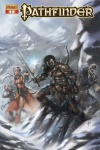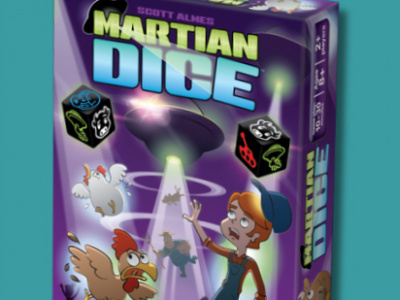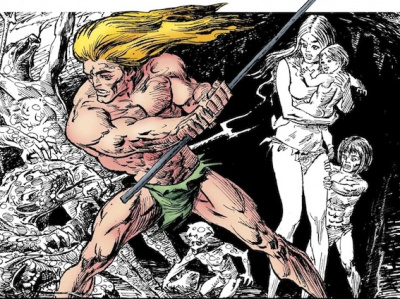
We recently caught up with Paizo Publisher Erik Mona and Jim Zub, writer of the upcoming Dynamite Entertainment comic series based on the Pathfinder RPG, to talk about the comics and their connections to the RPG. In Part 2, we talk about the game content in the comics and how the comics and games cross-promote. In Part 1, we talked about the creative process for the comics and how they connect to the game content.
You mentioned the supplementary material in the first issue that ties to the comic story. Is that material that has not been previously published or won’t be published in Pathfinder game products?
Mona: Yes, for the most part. For the first issue, it’s about Sandpoint which is a location we’ve touched on a couple of times, but it’s got some new information. As the series moves on from that starting point, we get into the second one that takes place in a forest that we haven’t done a lot of detail on. So as it gets a bit further afield, we’ll get into totally new content that is unavailable elsewhere.
What’s the creative process for that material? Is Jim creating that, or is it just drawn from his stories?
Mona: Jim has given us some suggestions and of course the outline and then James Jacobs, who is our creative director and the guy who is the mad genius behind the Pathfinder Adventure Paths, is the one doing all the writing in that back section. He helps us out with the characters as well.
Zub: I’ve been doing my best to do my due diligence on the series and make sure it’s as accurate as possible, and so far the guys have been pretty pleased with how that’s come together; but they’re giving it a close look over, which is nice too because it allows me to focus on the character first and make sure I’m telling a good character story and then the Paizo editorial can come it and let me know that everything is properly canon or the stuff is coming across properly or that it takes account of certain subtleties I may not have known about.
There is a lot of source material. They can make recommendations on ways to keep it on target with the type of story I’m telling, but make sure that it’s going to hit all the points they need as well.
Jim, you mentioned that you wanted to write this in way that someone that’s a fan of fantasy stories but not necessarily a gamer could enjoy it. Those fantasy fans might later get interested in the game and the comic might expand the audience for the core product. Are you doing anything specifically in the writing of the comic to tie it back to the game product to try to accomplish that?
Zub: I think the reality is that a good fantasy story is the key to any good roleplaying game, a Pathfinder game in particular. I don’t think it’s about marking off certain rules or making sure that people are picking up on particular rule elements, it’s about engaging characters and a great story. And if people realize this is from a game and that they can make their own story thanks to supplementary material or thanks to broadening of the Pathfinder brand, I think that’s a win for everyone involved.
Trying to make it a giant commercial for the game line from the get go is a mistake. The reality is that great roleplaying games are about stories, they’re about characters, they’re about engaging and entertaining. If I can do that well, if I can create entertaining and engaging characters, then it is the best advertisement that Pathfinder could get.
Erik, going back the other way. Anything you’re doing at Paizo specifically to draw game fans to the comics?
Mona: We’ve been talking about it on our blog. We’ll be doing a lot more of that in the future. We’re going to have Jim and hopefully the artist at Gen Con at our booth meeting fans and talking about the comic, and there may be some other stuff on the Website as well. I’m putting ads for the comic in our Pathfinder Adventure Paths and in Ultimate Equipment, which is our big hardcover coming out in August. That’s going to have a big full page ad pointing people to the comics
What is the length of the story arc you’re working on?
Zub: It’s a six issue story arc that we’re building for the first arc. And it could be flexible—anywhere between four to six issue story arcs for future story arcs if everything keeps rolling out the way that we’re planning. I want to make to make sure the story comes first and that it works well within that.
Dynamite said they wanted me to create something that would make a substantial chunk rather than doing one or two issue arcs. In addition, we’ve got six characters in our main cast so I wanted to have enough space to do a little bit of exploration with each of them and really build up, both to fans and to new readers, an understanding of who these characters are and what their motivations are.
Anything else that our readers should know to help them sell this product?
Mona: All I can say is I’m reading every single comic DC is releasing right now. I got into that New 52 thing, and I think Jim’s scripts are equal to or exceed the quality of most if not all of those comics. I’m very excited. I think Andrew Huerta’s art is fantastic. We put together what we feel is the very best Pathfinder comic we could do--I’m sure Jim feels the same way and I know Dynamite feels the same way. I’m excited to see what people say about it.
Zub: I think we’re doing a really good job of balancing those two extremes where you want to have the loyal fan base understand it and want to get involved in a comic based on a property that they love, and a new readership. You want to have both of those functioning in order to have the best use of the comic and to really engage people with a great story and with awesome art. That’s really my goal from the get go.
When I was talking to the Pathfinder guys and I was talking to the Dynamite, I said I’m going to focus on stories with great characters. You’ve got these iconic characters that have been designed, but they’ve never been fleshed out. Even though they’ve been on the covers of every single product and every source book, people don’t really know who they are. That’s a wonderful palette to be able to paint with and work with and build with. I don’t want to sound corny, but it’s been a real honor being able to fill in some of those gaps and being able to define those characters in a new way and give fans and new readers someone to cheer for.
Mona: I think Jim’s point is really important. The iconic characters, even though they appear pretty much in every single illustration from Pathfinder since five years ago when we launched the Adventure Paths, their backgrounds, their interactions and personalities have never really been detailed beyond a couple of sentences here and there in pre-generated character write-ups in the back of an Adventure. It was always my intention from the beginning that if we were ever to get Pathfinder to be successful enough, that we could have a really nice comic book then that would be the ideal place to tell these stories. So I’m thrilled to have Jim on board to be the one to do that.
Erik, you’re doing Pathfinder fiction?
Mona: Pathfinder Tales is our fiction line. We’ve done about a dozen books so far, they’re every other month.
Any crossover connection between the fiction content and the comic content?
Mona: Not right now. It’s one of those things where my hope is that if the comic is really successful, Dynamite’s M.O. is sometimes to launch additional series and I’d love to see some adaptations of the fiction, but right now we’re focusing on the iconic characters.
Zub: The iconics have never been used in Paizo’s fiction, they’ve focused on other characters instead.
Mona: They’re original characters of the different novelists. So for these characters, this is their first shot at being fleshed out.
Click here for Part 2.
Click here for Part 2.







